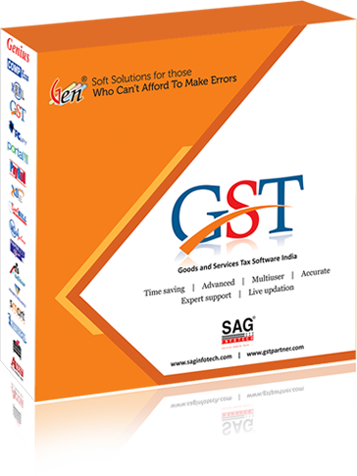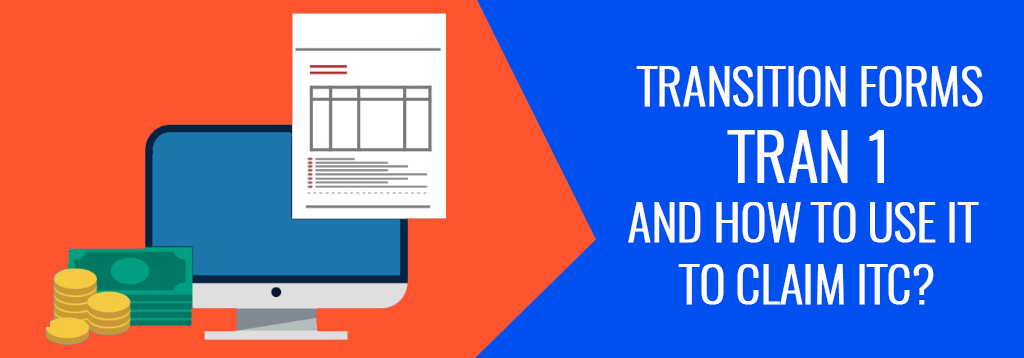CBEC has released Tran 1 and Tran 2 forms to make businesses transition smoothly and carry forward their input tax credit.
The GST TRAN 1 and TRAN 2 forms can be filed by the registered business owner under GST who were already registered under the old laws of indirect tax.
Contents
Did you know, What is Tran 1 and Tran 2 form?
Amongst many problems for businesses after the implementation of GST, one is related to the availability of Input Credit (ITC) on old stock. Most of these businesses, who still possess an old stock of supplies, had already paid taxes (VAT and/or Service Tax) under the previous tax regime on the purchases of raw materials and other goods.
Now, they seek to carry over the input credit when transitioning to the new GST regime. To put their minds to ease, the government is allowing such businesses to claim and carry forward their eligible credits from earlier tax regime to GST.
However, there is a time limit on the claims of such credits and there are certain conditions businesses need to meet in order to be eligible for the claim. Continue reading to find out about the format of GST Tran-1, GST Tran-1 due date and more.
There are basically two types of transitional credits here.
- First – tax paid on the capital stock or old stock (closing balance of CENVAT) – will be claimable in form of ITC in GST regime.
- Second – unavailed ITC on closing stock from the previous tax regime – will be carried forward to GST, for some businesses.
Format of GST TRAN 1 and TRAN 2 Forms
Click on the below links to download GST Tran 1 and Tran 2 forms in PDF format
Download GST Tran-1 Form in PDF
Download GST Tran-2 Form in PDF
GST Tran-1/Tran-2 Due Date
The last date for filing Tran-1 and Tran-2 forms to claim the credit of tax paid on an old stock are as below.
- Businesses who wish to discharge July month’s tax liability through transitional credit (of old stock) – need to apply on or before 28th August 2017.
- GST Tran-1 due date: Businesses eligible for transitional ITC through Tran-1 should apply on or before 31st December 2017.
- Those eligible for transitional ITC through Tran-2 can apply monthly on or before 30th June 2018.
ITC on old stock – Eligibility Conditions
Any business, whether registered or not registered under previous tax regime, having old stock, can claim the credit for already paid tax, given that they follow the conditions as mentioned below.
- Businesses registered under earlier tax regime having old stock are eligible.
- Business registered under VAT and having paid Excise duty on the closing stock as on 30th June 2017.
- Businesses not registered before but registered under GST and having an old stock with tax paid.
- Those manufacturing/selling GST exempted goods that were taxable in the previous tax regime and have already paid tax on their old stock.
- Those, who were composition dealers in the earlier regime but not under GST, can claim input credit on their capital stock as on 30th June 2017.
- A business must have filed last six monthly returns under old laws before GST.
- The old stock items currently under the manufacturing or job work process, are also eligible.
- Businesses having unavailed credit (ITC) on capital goods (from old tax regime) can claim to transfer the same to the GST regime.
- Businesses registering or registered under the composition scheme of GST are not eligible.
ITC on old stock – How to Claim?
The CBEC has introduced two transition forms, namely TRAN 1 and TRAN 2, to help businesses transition to the new tax system smoothly and carry forward the ITC from before.
- TRAN 1 – To be used by GST Registered people (registered or not registered under old regime)
- TRAN 2 – To be used by GST Registered people not registered under old regime or those who do not have the documents/bills/proof of duty paid on old stock
In this article, we will discuss the ITC claim process using TRAN 1 form.
What is TRAN 1 form and How to use it to claim ITC?
Any person who wishes to claim ITC on the tax paid on their old stock, need to do two things: file GST Tran-1 form and sell the old stock within 6 months from 1st Jul 2017.
How to file Tran-1 Form?
Follow the steps below:
Step 1: Visit GSTN portal and log into your GST account.
Step 2: Select Services > Returns > Transition Forms
Step 3: Choose ‘Yes’ or ‘No’ for whether you have successfully filed previous six monthly returns under old laws before the launch of GST. The Tran-1 form will open with specific options based on your selection.
Step 4: Fill in the details in each field of each table and click on ‘Save’ button at the bottom. The system will show if there is any validation error, otherwise, your form will be saved.
- First, enter your details like GSTIN, legal name, trade name, etc. and save.
- Furnish the details of credit to be carried forward to GST
- Amount of Cenvat credit carried forward to e-credit ledger as CGST
- Details of statutory forms received for which credit is being carried forward
- Amount of tax credit carried forward to e-credit ledger as State/UT Tax (SGST)
- Enter details of capital goods for which credit has not been availed under previous laws and is eligible to be carried forward to GST.
- Amount of unavailed cenvat credit (in respect of capital goods) carried forward to e-credit ledger as CGST
- Amount of unavailed ITC carried forward to e-credit ledger as SGST/UTGST
- Enter the details of the inputs held in stock to avail the credit of already paid taxes and duties under previous laws and eligible under GST regime.
- Amount of duties and taxes on inputs claimed as credit
- Amount of VAT and Entry Tax paid on inputs supported by invoices/docs evidencing payment of tax carried forward to credit ledger as SGST/UTGST
- Stock of goods not supported by invoices/evidence of payment of tax (Only for States having VAT at single point)
- Enter the details of transfer of cenvat credit for the registered person having centralized registration under previous laws.
- Details of goods sent to job worker and held in his stock on behalf of principal (by both job worker and the principal business)
- Details of goods sent as principal
- Details of goods held in stock as job worker
- Details of goods held in stock by agents on behalf of the actual owner and eligible ITC.
- Details of goods held as agent on behalf of the principal
- Details of goods held by the agent
- Details of transition credit availed on transactions on which tax (both service tax and VAT) has been paid under earlier laws and are also applicable under GST.
- Details of goods sent on approval basis six months prior to the appointed day.
Step 5: Click on ‘Submit’ button to save the details and submit the Tran-1 form. (The form once submitted cannot be modified, so make sure to enter correct details and validate before submitting.)
* Once the Tran-1 form is submitted successfully, the transition credit claimed will be posted to the e-credit ledger of the applicant. However, the credit can only be used after filing of Tran-1 by signing it.
Step 6: Click the ‘File’ button using DSC or EVC. A message will generate for a successful filing. You can download the acknowledgement for the same.
Other Important Things to Know
- The ITC you wish to carry forward from old tax regime must also be eligible under GST regime.
- The input credits from old tax system can be transferred to GST only if the person has filed his past six monthly returns under the old system without any miss.
- Credits of any central taxes including excise duty and service tax will be treated as CGST.
- Credits of state taxes including VAT will be treated as SGST.
- ITC claimed on an old stock can be used to pay the output tax liability of GSTR 3B and/or subsequent GST returns.






